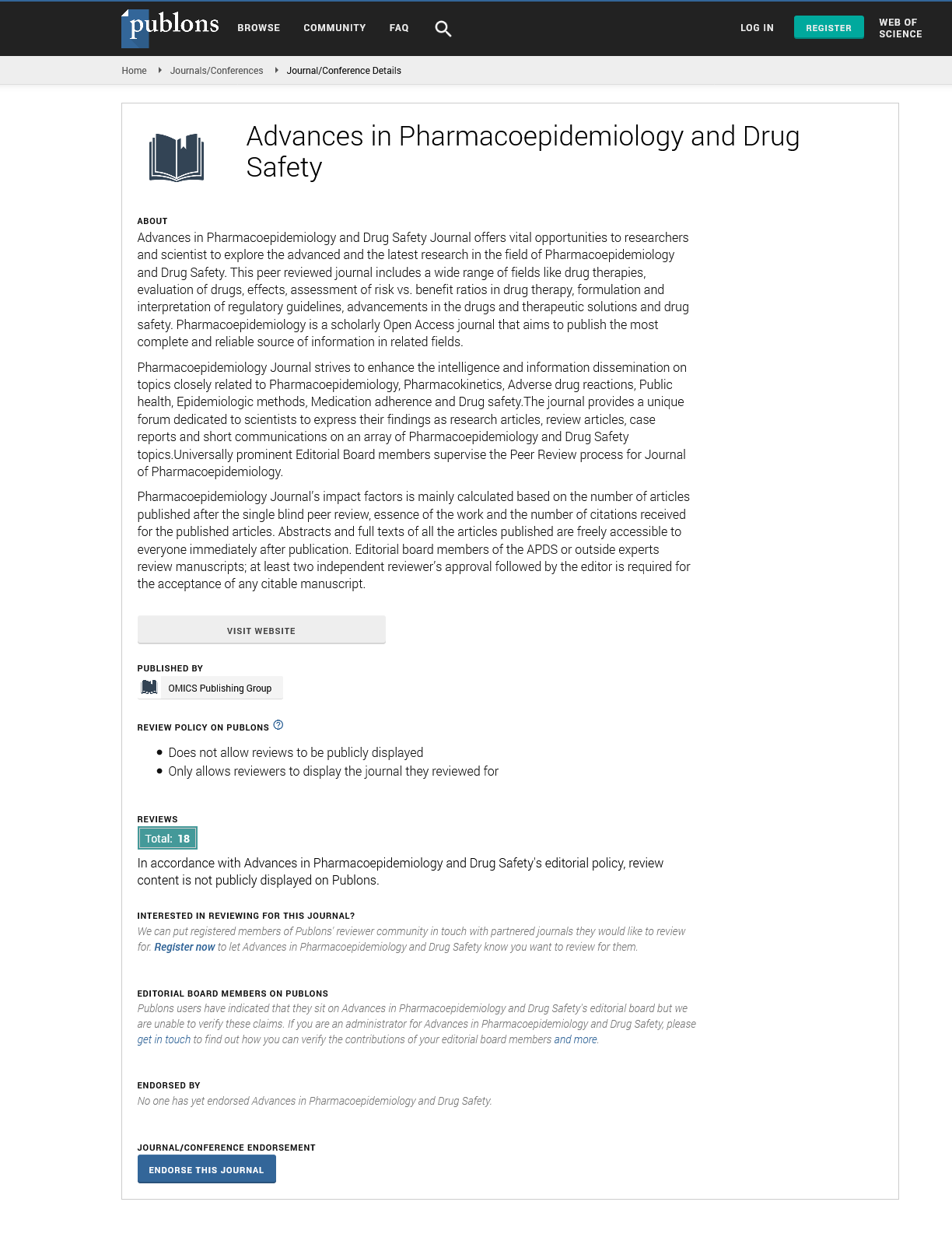Indexed In
- Open J Gate
- Genamics JournalSeek
- Academic Keys
- JournalTOCs
- RefSeek
- Hamdard University
- EBSCO A-Z
- SWB online catalog
- Publons
- Geneva Foundation for Medical Education and Research
- Euro Pub
- Google Scholar
Useful Links
Share This Page
Journal Flyer

Open Access Journals
- Agri and Aquaculture
- Biochemistry
- Bioinformatics & Systems Biology
- Business & Management
- Chemistry
- Clinical Sciences
- Engineering
- Food & Nutrition
- General Science
- Genetics & Molecular Biology
- Immunology & Microbiology
- Medical Sciences
- Neuroscience & Psychology
- Nursing & Health Care
- Pharmaceutical Sciences
Short Communication - (2023) Volume 12, Issue 3
A Comprehensive Overview of Crude Drugs: Nature's Pharmacological Treasure
Jennifer Jordan*Received: 10-May-2023, Manuscript No. PDS-23-21747; Editor assigned: 15-May-2023, Pre QC No. PDS-23-21747 (PQ); Reviewed: 29-May-2023, QC No. PDS-23-21747; Revised: 06-Jun-2023, Manuscript No. PDS-23-21747 (R); Published: 13-Jun-2023, DOI: 10.35248/2167-1052.23.12.317
Description
Crude drugs, also known as herbal drugs or natural drugs have been used for centuries by different cultures around the world for their medicinal properties. Derived from various parts of plants and other natural sources, crude drugs are unprocessed or minimally processed substances that contain active compounds capable of providing therapeutic benefits. Crude drugs have a rooted in ancient civilizations [1]. In early human societies, plants were the primary source of medicine, and knowledge of their medicinal properties was passed down through generations [2]. Ancient civilizations such as the Egyptians, Greeks, and Chinese extensively documented the use of crude drugs for treating various ailments [3]. The Ebers Papyrus from ancient Egypt and the works of Hippocrates in Greece are notable examples of early pharmacological texts that detail the use of crude drugs [4].
Sources of crude drugs
Crude drugs can be derived from various parts of plants, including leaves, stems, roots, bark, flowers, and seeds. Each part may possess unique chemical constituents, making them suitable for different therapeutic purposes. For example, the leaves of Digitalis purpurea (foxglove) contain cardiac glycosides used in the treatment of heart conditions, while the bark of Cinchona spp. yields quinine, a potent antimalarial compound [5]. Apart from plants, other sources of crude drugs include animal- derived substances like bee venom or snake venom, minerals like sulfur or arsenic, and microbial products such as penicillin. While plant-based crude drugs dominate the field, these alternative sources have also contributed to traditional and modern medicine [6].
Preparation of crude drugs
The preparation of crude drugs involves harvesting the plant material and subjecting it to various processing methods to obtain the desired therapeutic compounds. The most common methods include drying, grinding, and extraction. Drying helps remove excess moisture from plant materials, reducing the risk of microbial contamination and degradation of active constituents. Grinding or pulverizing the dried plant material increases its surface area, aiding in subsequent extraction [7]. Extraction is a crucial step in obtaining crude drugs. It involves the use of solvents like water, alcohol, or organic solvents to dissolve the active compounds from the plant material. Different extraction techniques, such as maceration, percolation, decoction, or distillation, are employed depending on the characteristics of the plant and the desired compounds [8].
Pharmacological significance
Crude drugs are valued for their pharmacological significance due to the presence of bioactive compounds [9]. These compounds exert their effects through various mechanisms, including modulation of enzymatic activity, interaction with cellular receptors, or alteration of signaling pathways. Many well-known drugs used in modern medicine have their origins in crude drugs. For example, aspirin, derived from willow bark, exhibits analgesic, anti-inflammatory, and antipyretic properties. Crude drugs also offer advantages over synthetic drugs. They often have a complex mixture of compounds, which can lead to synergistic interactions and improved therapeutic outcomes. Moreover, they are perceived as more natural and potentially safer alternatives to synthetic drugs, as they are derived from natural sources and are often well-tolerated by the human body. The use of crude drugs in modern medicine poses challenges related to standardization, quality control, and dosage determination [10].
References
- Lee M, Saver JL, Liao HW, Lin CH, Ovbiagele B. Pioglitazone for secondary stroke prevention: a systematic review and meta-analysis. Stroke. 2017;48(2):388-393.
[Crossref] [Google Scholar] [PubMed]
- Shamshina JL, Barber PS, Rogers RD. Ionic liquids in drug delivery. Expert opinion on drug delivery. 2013;10(10):1367-381.
[Crossref] [Google Scholar] [PubMed]
- Boumil MM, Beninger PR. The alendronate conundrum: balancing the competing influences for truly informed consent about drug safety in an era of rapid change. Clinl Ther. 2023.
[Crossref] [Google Scholar] [PubMed]
- Chen W, Li Z, Cheng Y, Li G, Li J, Huang L, et al. Content analysis and drug safety evaluation of four furanocoumarins in six pomelos produced in China. Nat Pro Res. 2023:1.
[Crossref] [Google Scholar] [PubMed]
- Piper JM, Wen TT, Xenakis EM. Interferon therapy in primary care. Prim Care Update Ob Gyns. 2001;8(4):163-169.
- Risbridger GP. Human cell lines as tools of our trade: “laying it on the (cell) line”. Mol Endocrinol. 2015;29(1):1-2 Risbridger GP. Human cell lines as tools of our trade: “laying it on the (cell) line”. Mol Endocrinol. 2015;29(1):1-2 Risbridger GP. Human cell lines as tools of our trade: “laying it on the (cell) line”. Mol Endocrinol. 2015;29(1):1-2.
[Crossref] [Google Scholar] [PubMed]
- Erspamer V. Pharmacology of indolealkylamines. Pharmacol Rev. 1954;6(4):425-487.
[Google Scholar] [PubMed]
- Friedman RM. Clinical uses of interferons. Br J Clin Pharmacol. 2008;65(2):158-162.
[Crossref] [Google Scholar] [PubMed]
- George PM, Badiger R, Alazawi W, Foster GR, Mitchell JA. Pharmacology and therapeutic potential of interferons. Pharmacol Ther. 2012;135(1):44-53.
- Geraghty RJ, Capes-Davis A, Davis JM. Guidelines for the use of cell lines in biomedical research. Br J Cancer. 2014;111(6):1021-1046.
[Crossref] [Google Scholar] [PubMed]
Citation: Jordan J (2023) A Comprehensive Overview of Crude Drugs: Nature's Pharmacological Treasure. Adv Pharmacoepidemiol Drug Saf. 12:317.
Copyright: © 2023 Jordan J. This is an open-access article distributed under the terms of the Creative Commons Attribution License, which permits unrestricted use, distribution, and reproduction in any medium, provided the original author and source are credited.

